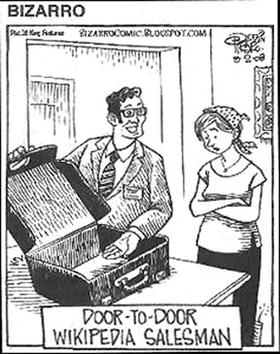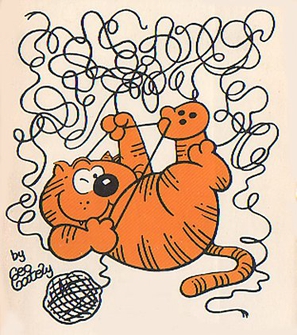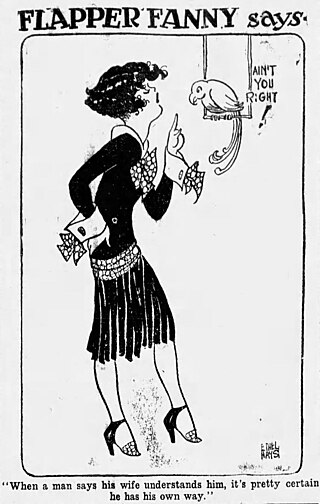A comic strip is a sequence of cartoons, arranged in interrelated panels to display brief humor or form a narrative, often serialized, with text in balloons and captions. Traditionally, throughout the 20th and into the 21st century, these have been published in newspapers and magazines, with daily horizontal strips printed in black-and-white in newspapers, while Sunday papers offered longer sequences in special color comics sections. With the advent of the internet, online comic strips began to appear as webcomics.

The Far Side is a single-panel comic created by Gary Larson and syndicated by Chronicle Features and then Universal Press Syndicate, which ran from December 31, 1979, to January 1, 1995. Its surrealistic humor is often based on uncomfortable social situations, improbable events, an anthropomorphic view of the world, logical fallacies, impending bizarre disasters, references to proverbs, or the search for meaning in life. Larson's frequent use of animals and nature in the comic is popularly attributed to his background in biology. The Far Side was ultimately carried by more than 1,900 daily newspapers, translated into 17 languages, and collected into calendars, greeting cards, and 23 compilation books, and reruns are still carried in many newspapers. After a 25-year hiatus, in July 2020 Larson began drawing new Far Side strips offered through the comic's official website.

Bizarro is an award-winning single-panel cartoon written and drawn by cartoonist Dan Piraro and later by cartoonist Wayne "Wayno" Honath. The cartoon specializes in surrealist humor and at times is slightly cryptic in its humor. The creator often includes hidden symbols in the drawing which refer to inside jokes or other elements.

Heathcliff is an American comic strip created by George Gately in 1973, featuring the title character, an orange cat. Now written and drawn by Gately's nephew, Peter Gallagher, it is distributed to over 1,000 newspapers by Creators Syndicate, which took over the comic from McNaught Syndicate in 1988.

The Born Loser is a newspaper comic strip created by Art Sansom in 1965. His son, Chip Sansom, who started assisting on the strip in 1989, is the current artist. The strip is distributed by Newspaper Enterprise Association. The Sansoms won the 1987 National Cartoonists Society Humor Comic Strip Award and the 1990 Newspaper Comic Strip Award.

Skippy is an American comic strip written and drawn by Percy Crosby that was published from 1923 to 1945. A highly popular, acclaimed and influential feature about rambunctious fifth-grader Skippy Skinner, his friends and his enemies, it was adapted into movies, a novel and a radio show. It was commemorated on a 1997 U.S. Postal Service stamp and was the basis for a wide range of merchandising—although perhaps the most well-known product bearing the Skippy name, Skippy peanut butter, used the name without Crosby's authorization, leading to a protracted trademark conflict.

Lady Luck is an American comic-strip and comic-book crime fighter and adventuress created and designed in 1940 by Will Eisner with artist Chuck Mazoujian. She starred in a namesake, four-page weekly feature published in a Sunday newspaper comics insert colloquially called "The Spirit Section", which ran from June 2, 1940, to November 3, 1946. Her adventures were reprinted in comic books published by Quality Comics. A revamped version of the character debuted in 2013 in DC Comics's Phantom Stranger comic.

Mickey Finn was an American comic strip created by cartoonist Lank Leonard, which was syndicated to newspapers from April 6, 1936 to September 10, 1977. The successful lighthearted strip struck a balance between comedy and drama. It was adapted to a 400-page Little Big Book and was reprinted in several comic book series throughout the 1930s and 1940s.

Henry Boltinoff was an American cartoonist who worked for both comic strips and comic books. He was a prolific cartoonist and drew many of the humor and filler strips that appeared in National Periodical comics from the 1940s through the 1960s.

Betsy and Me is a humorous American comic strip about a dysfunctional, post-war American middle-class family, created by Jack Cole (1914–1958). It was written and drawn first by Cole and then, after his death, by Dwight Parks. Distributed by Chicago Sun-Times Syndicate, the strip ran from May 26 to December 27, 1958.

Our Boarding House is an American single-panel cartoon and comic strip created by Gene Ahern on October 3, 1921 and syndicated by Newspaper Enterprise Association. Set in a boarding house run by the sensible Mrs. Hoople, it drew humor from the interactions of her grandiose, tall-tale-telling husband, the self-styled Major Hoople, with the rooming-house denizens and his various friends and cronies.

Flapper Fanny Says was a single-panel daily cartoon series starting on January 26, 1925, with a Sunday page following on August 7, 1932. Created by Ethel Hays, each episode featured a flapper illustration and a witticism. The Sunday strip concluded on December 8, 1935; the daily panel continued until June 29, 1940.

Irving Walter Phillips was a noted American cartoonist, playwright, television scriptwriter, author, illustrator and educator. He is best remembered for his daily newspaper comic panel The Strange World of Mr. Mum.
Although, traditionally, female comics creators have long been a minority in the industry, they have made a notable impact since the very beginning, and more and more female artists are getting recognition along with the maturing of the medium. Women creators have worked in every genre, from superheroes to romance, westerns to war, crime to horror.
Luther is an American syndicated newspaper comic strip published from 1968 to 1986, created and produced by cartoonist Brumsic Brandon Jr. The series, about an African-American elementary-school child, was the second mainstream comic strip to star an African-American in the lead role, following Dateline: Danger! (1968-1974), the first to do so. Another predecessor, Wee Pals (1965-2014), featured an African-American among an ensemble cast of different races and ethnicities.
Quincy is an American syndicated newspaper comic strip published from July 13, 1970 to October 4, 1986, created and produced by cartoonist Ted Shearer. The series, about an African-American boy being raised by his grandmother in Harlem, was one of the earliest mainstream comic strips to star an African American in the lead role, following Dateline: Danger! (1968-1974) and Luther (1969-1986). Another predecessor, Wee Pals, features an African-American among an ensemble cast of different races and ethnicities.

Brumsic Brandon Jr. was an African-American cartoonist whose 1969-1986 Luther was one of the earliest mainstream comic strips to feature an African American in the lead role.
Winthrop is an American syndicated newspaper comic strip that was published between 1966 and 1994, created and produced by cartoonist Dick Cavalli. The series—which derived its comedy from a group of children's nonchalantly world-wise observations—evolved from Cavalli's 1956-1966 strip, Morty Meekle, which featured adult characters.
Morty Meekle is an American syndicated newspaper comic strip that was published between 1956 and 1966, created and produced by cartoonist Dick Cavalli. The series featured the title character dealing with office and dating situations, and, like Fritzi Ritz, which became Nancy after sixteen years, evolved to focus on the younger characters from Cavalli's strip, and was renamed Morty Meekle and Winthrop and then just Winthrop on February 27, 1966.
Melvyn Keefer was an American comics artist and illustrator. Best known for the comic strip Mac Divot, he was a lifetime Inkpot Award inductee.














